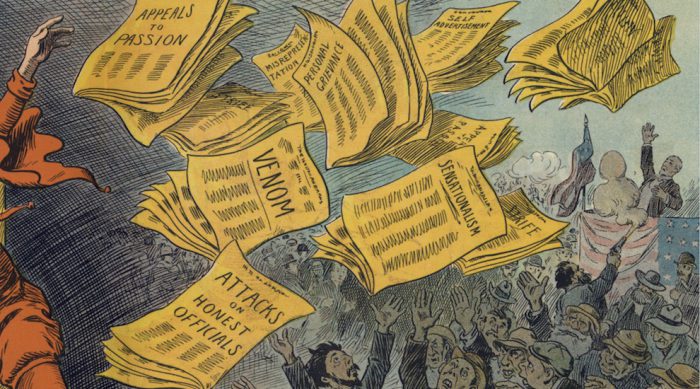
The growing stream of reporting on and data about fake news, misinformation, partisan content, and news literacy is hard to keep up with. This weekly roundup offers the highlights of what you might have missed.
Feel-good fake news: Following Wednesday’s terrorist attack in London, an image of a Tube sign has gone viral:
The inspiring Tube sign everyone is sharing after the Westminster attack … is fake https://t.co/rtiovyn1am by @robaeprice pic.twitter.com/cFCFlzZ9vv
— Jim Edwards (@Jim_Edwards) March 23, 2017
It’s fake, a Photoshop job (as are many images of these signs that you see on Twitter), but The Verge’s James Vincent notes that people including politicians and journalists are arguing that that doesn’t really matter: “Sky News presenter Kay Burley tweeted the sign this morning, then followed up by saying: ‘For the avoidance of doubt this is a computer generated sign but nevertheless a sentiment shared by millions.’ BBC Radio 4 presenter Nick Robinson read the sign out live on air this morning, but later tweeted: ‘Well, you learn something every day. That lovely tube sign might be ‘fake’ but the sentiment isn’t for thousands sharing it’…the idea that sentiment is more important than veracity seems to be widespread, with plenty of people — again, including journalists — saying that ‘fact-checking’ the sign is ‘missing the point.'”
In the comments of The Verge’s post, readers debated whether fake news is the same thing as a meme and whether a meme is the same thing as propaganda; some argued that the sign couldn’t be fake news because it didn’t state a fact and didn’t have malicious intent. One thought: I wouldn’t actually qualify this (fake) sign as apolitical; it’s feel-good but carries a broader message in support of the multiculturalism of London, somewhat akin to this in New York City following Trump’s election, and it is essentially the kind of sentiment that Donald Trump Jr. was attacking in a tweet Wednesday.
Facebook’s fake news alerts spotted in the wild: Facebook announced back in December that it was partnering with fact-checking organizations to clamp down on viral fake news; three months later, users began spotting the system in action when they tried to share a story called “The Irish Slave Trade — The Slaves That Time Forgot,” published by a blog called Newport Buzz. The AP separately debunked the story. Guardian staffers attempted to share the story on Facebook in various regions, Elle Hunt notes: “Attempts by the Guardian in San Francisco to publish the Newport Buzz story triggered the tool, but not in Sydney or London.” Quartz’s Nikhil Sonnad notes the many many steps you must go through if you want to post the story (in an area where the fact-checking feature is turned on).
A value of $25!
LinkedIn claims it has no fake news problem: “People come to LinkedIn for a reason. Whatever it is they’re doing in their professional world is what they want to talk about. That alone rules out a lot of what would constitute ‘fake news.’ This is not the place where you post conspiracy theories about a pizza chain,” LinkedIn editor-in-chief Dan Roth told Engadget while promoting the company’s new “Trending Topics” section. Gizmodo’s Bryan Menegus begs to differ: “A quick search on LinkedIn reveals no shortage of posts about the DC pizza parlor’s supposed child-trafficking proclivities…Fake news hasn’t been a major problem for LinkedIn, so an initiative to solve this complicated issue through a new feature is at best disingenuous — because LinkedIn is, by in large, not a destination for most people to get news from.”
Dr. Fraud: 48 out of 360 academic journals accepted a fake application for a fake editor, a team out of Poland’s University of Wrocław found, writing up its results in Nature. The New Yorker’s Alan Burdick has more on “predatory journals”, which have been enabled by the rise of the Internet. Jeffrey Beall, an associate professor and librarian at the University of Colorado, Denver, attempted to keep a list of these spam journals from 2011 until this year: “In late January he abruptly shut down the site for good, for reasons he preferred not to elaborate on. ‘There was pressure from my university to stop,’ he said. ‘Universities don’t like negative things; they like happy, smiling people, not a lot of politics. I kind of feared for my job.'” (Earlier.)
“Someone could just be jumping through a roof and landing on a trampoline.” The New York Times profiled a Brooklyn middle school that is teaching its students news literacy for online content. “You’re living in a different world than we grew up in,” one teacher told her seventh graders. The curriculum was inspired by the news literacy program at Stony Brook University. But “introducing this at the university level is way, way too late,” Howard Schneider, the dean at Stony Brook’s journalism school, told the Times’ James Barron. “The ideal time is middle school, he said, when students are Internet-savvy but not yet immersed in social media.”